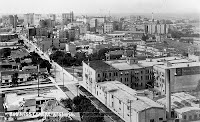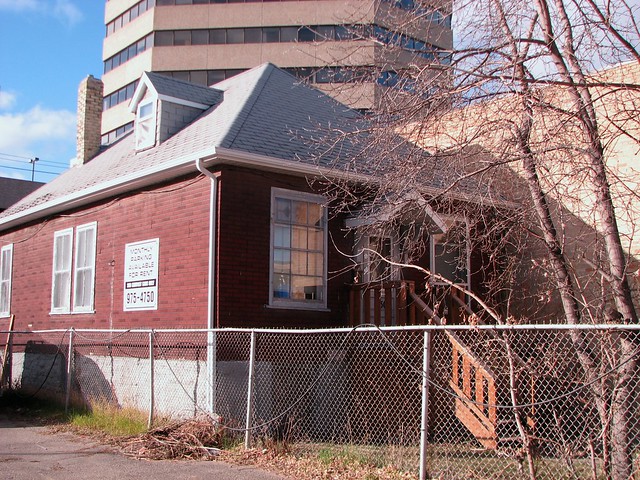Constructed: 1902-03
Architect and contractor: Unknown
This little house on Fort Street near York Avenue is one of the few remaining houses in what was once a substantially residential downtown business district. Others include one on Graham Avenue and the recently demolished 175 Donald Street.
Though it has been used as a commercial space over the past couple of decades it is still zoned residential and boasts 1,800 square feet over 2 1/2 levels.
April 24, 1907, Winnipeg Tribune
Built in 1902 - 03, right after sewer was installed on the street, its first owner was William J. Squires. A cab driver by trade, in 1903 he was hired to manage the newly formed Winnipeg Cab Company. That year, they opened a garage and offices nearby on Smith Street.Business must have been good as in 1904 Squires and family moved to the suburban confines of Furby Street.
April 13, 1904, Manitoba Free Press
The next owner of the home was Anthony Swanson and family. He ran a tile, concrete and granolite yard from there. (The latter was a cement – granite mix used in city sidewalks and driveways.)
The company itself might not have lasted long. By 1905, Swanson is listed in Henderson Directories as a cement worker, then a labourer.
Around 1906, the family began renting out a room. their lodgers included August Holtz (1906), a labourer at the CPR and Margaret Bennett (1913), a stenographer.
In 1907, Mrs. Hilda Swanson died but Mr. Swanson continued to live there until at least 1914. That year, he opened up the house to three renters at a time. This was common during the war as families were split up and had to downsize. Small accommodations were in strong demand.
April 10, 1917, Winnipeg Tribune
A wartime resident was Sydney Beadle, a news agent, and his wife, Belinda. They lived on Poplar Avenue when he enlisted but by the time he was shipped overseas in June 1916, they had moved to 130 Fort Street.
While living there, Belinda received two distressing telegraphs from the war office informing her that her husband had been wounded.
The first was a shrapnel wound to the hand in March 1916, but he rejoined his unit a week later. In April 1917, he received gunshot wounds to the left breast and thigh. A piece of shrapnel was lodged under one of his ribs and doctors decided that it was too dangerous to operate on.
He was reassigned to a non-fighting unit but the pain from the embedded shrapnel was too great to allow him to use his arm properly. He was declared medically unfit and shipped back home to Winnipeg in April 1918.
By this time, Belinda had relocated again to 288 Main Street. Once reunited, the couple resettled on Poplar Ave where he worked at Brathwaite's, a south Main Street drug store.
March 11, 1922, Winnipeg Tribune
There was a spell when a number of tailors at Duncan Cameron’s tailor shop lived there. In 1919, it was Henry Nordman and George Eng and his family. George died in 1920 and Henry Hill, another Duncan’s tailor, moved in.
From time to time, a Swanson would appear at the house as a resident. The family as a whole returned from 1922 to 1924.
October 24, 1927, Manitoba Free Press
It appears a change in ownership came around 1927 when William and Mrs. Fudge moved in. He was a labourer at the CPR and they rented out a couple of rooms, often to other railway employees.
Mr. Fudge also has a sideline - selling liquor illegally.
The morality squad did a crackdown in October 1927 and Fudge got caught up in it. The following February he was found guilty, fined $200 and sentenced to two weeks in jail. A year later Mrs. Fudge was fined for the same thing.
The Fudges continued to live there into the 1930s. In 1936 they celebrated their 20th wedding anniversary at the house, along with 20 guests they somehow managed to squeeze in.
Through the 1940s and early 1950s it appears to have had a succession of short-term owners. Robert Ramsay - no occupation listed, John McGirr - insurance agent, C.L. Tardiff, Harold Norquay - city labourer, Arthur Lounsbury - CNR Express employee, Frank Jackson, truck driver.
October 30, 1970, Winnipeg Free Press
In 1956, Joseph Dumas, a widower, bought the house. He listed his occupation as a real estate agent and worked from home. He was also a noted bootlegger.
Dumas was arrested and fined numerous times for illegally selling liquor starting in the mid 1950s.
Even old age didn't slow him down. In 1967, at age 81, he was arrested for selling a bottle of liquor to an undercover officer. They raided his house and found 21 more. He reportedly told them that he was willing to "pay his fine like a man."
In 1970, after being caught for the same offense, when the magistrate fined him $400 he pulled out a wad of bills and offered to pay it on the spot.
Dumas died in 1978 at the age of 92.
September 8, 2014, Winnipeg Free Press
In the late 80s and through the 1990s it was home to Quaternary Consultants Ltd, an environmental consulting firm.
Source: Winterbos on Flickr
It was likely thanks to Dumas that the house has remained standing.
Due to its proximity to Main Street, Fort has always had a mix of residential and commercial properties. In the above photo of Fort Street, ca. late 19-teens, 130 and a couple of neighbouring houses can be seen in the bottom left.
December 24, 1949, Winnipeg Free Press
In 1926, King Auto Heater Company opened at 136 Fort. In 1928, the GMC Building opened and, in 1930, came the Radio Building. Over the decades other commercial buildings joined them, especially automobile-related businesses like car dealerships and garages.
In 1946, Princess Auto Wrecking moved from their original premises at 127 Princess Street into the properties immediately north of the house, 136 - 150 Fort Street..By 1960, the company was known as Princess Auto and Machinery, specializing in auto parts.
Lonely House in 2007
Through the 1950s and 60s pressure must have been on Dumas to sell the house to become a surface parking lot to serve either the Radio Building or Princess Auto, which was is the fate of the houses around it.
By the time Dumas died, however, that pressure would have eased and it left the house looking very much out of place in a commercial landscape.












You didn't mention the time during the 80's when the house served as a hub for the Winnipeg punk rock scene.
ReplyDeleteIts always hardest to find the most recent history of a building. If you can provide any details about its more recent decades, please feel free to send me an email at cassidy-at-mts.net
DeleteYeah i would like to hear more about the winnipeg punk scene part thats so neat
DeleteI think at that time there a local band promoter named Some Guy Presents and he lived and worked out of there booking bands for the local pub scene.
DeleteYeah that's a lot of history missed in this article! I lived there for 3 months in 88.
ReplyDeleteIts always hardest to find the most recent history of a building. If you can provide any details about its more recent decades, please feel free to send me an email at cassidy-at-mts.net
DeleteThere was a stone sign in the front yard of 130 Fort for most of the 90's. the stone read, "Mrs. R. Diner Block" which I learned was a one-storey jobby at Henry and Martha, demolished to make way for the Booth Centre. the stone was later removed to parts unknown.
Delete